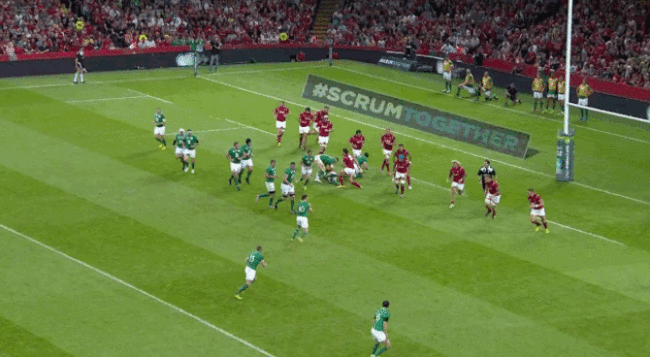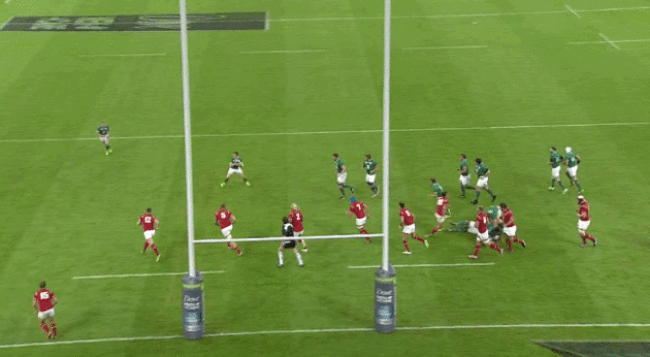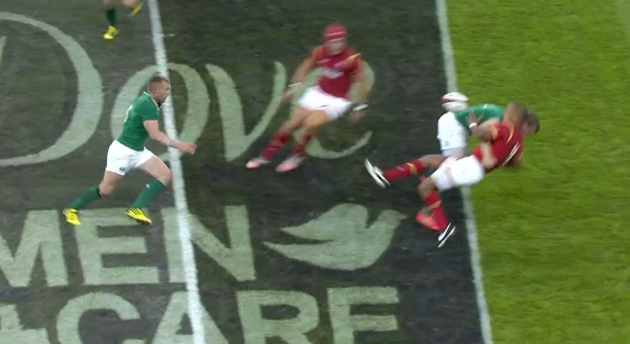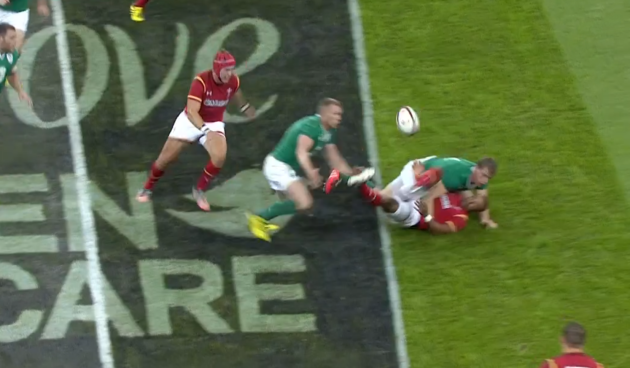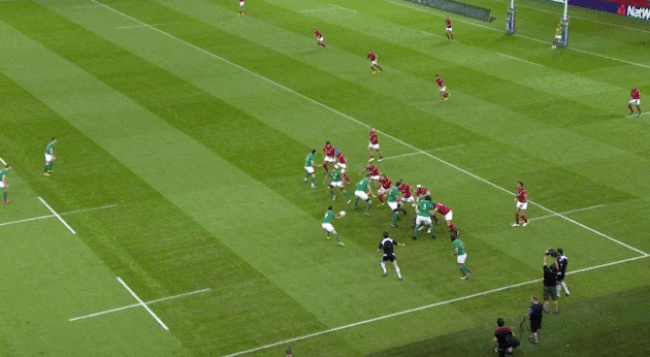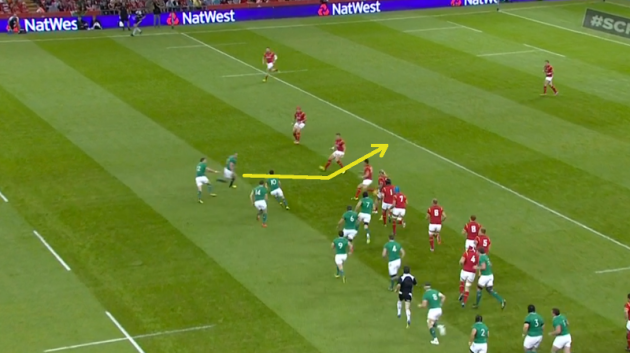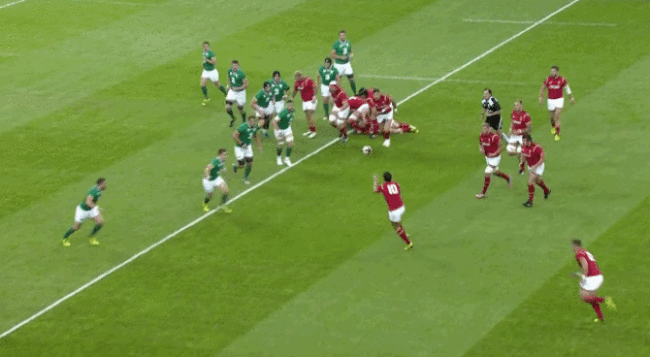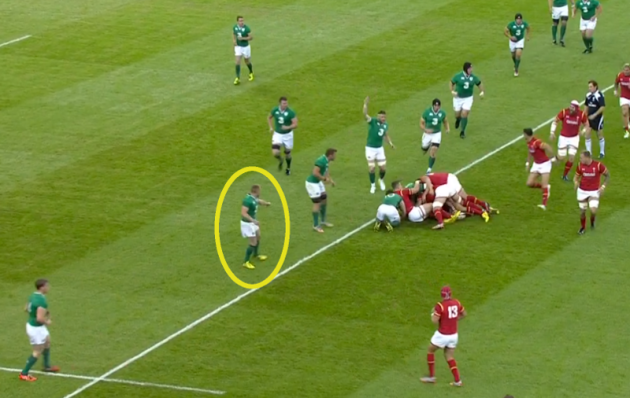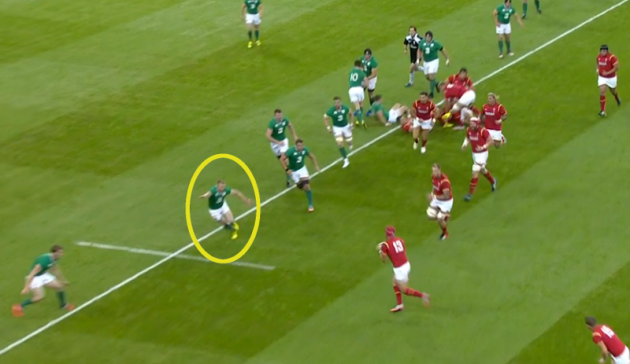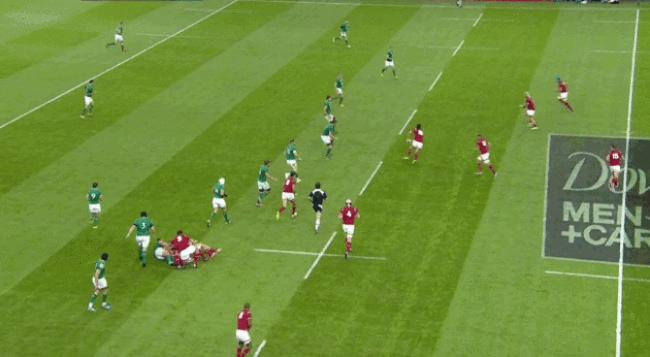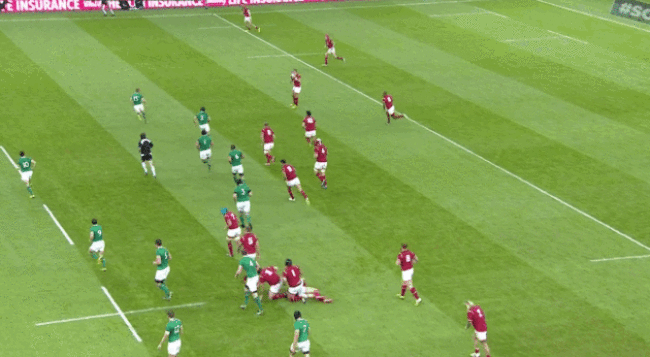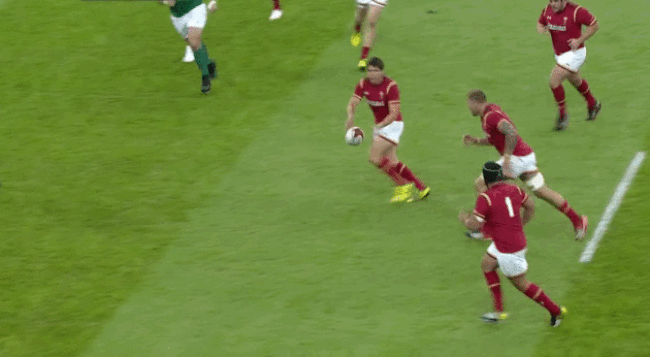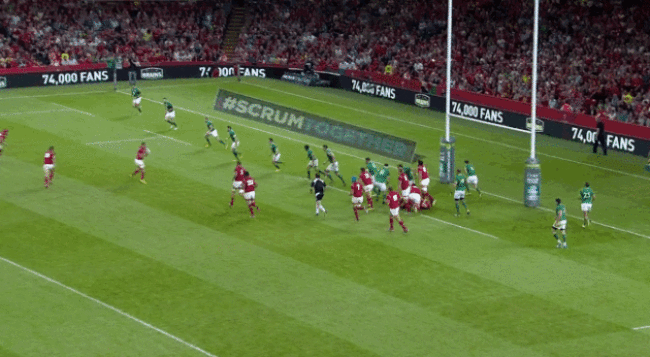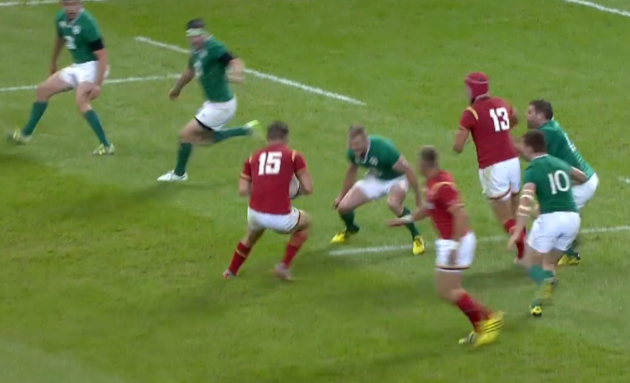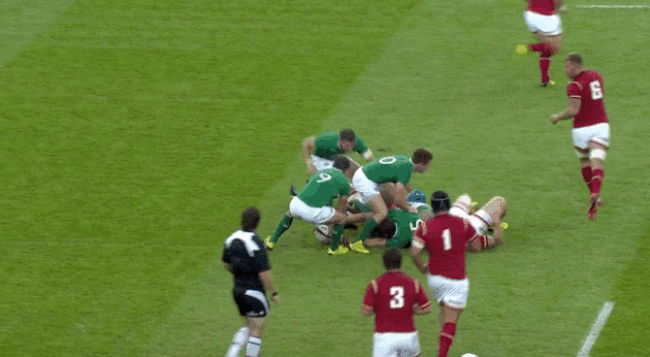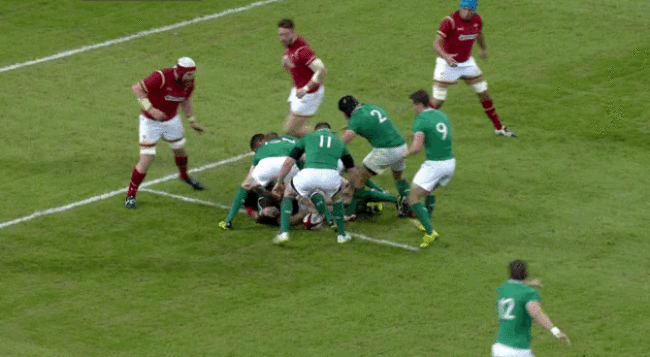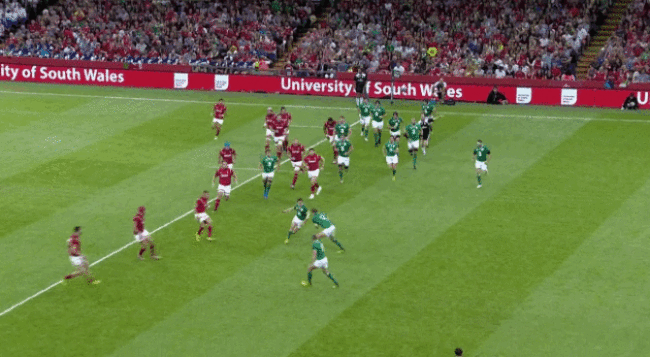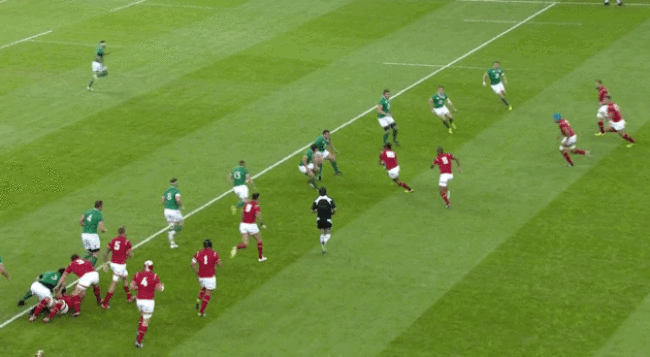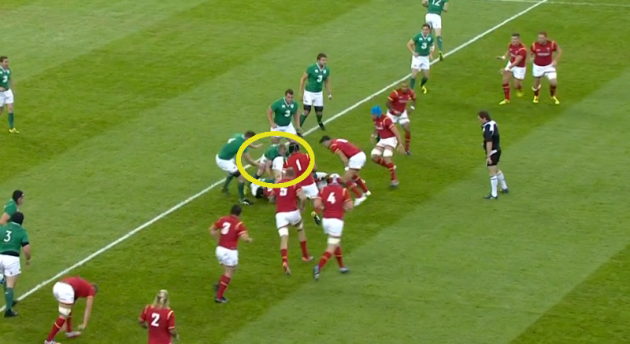AFTER A HIATUS of more than two years, Keith Earls was back in an Ireland jersey yesterday, impressing enough to the earn the man of the match award in a comfortable win against a weak Wales team.
The Limerick native hadn’t worn Ireland’s 13 shirt since November 2012, when he started at outside centre against South Africa and Argentina.
Earls is likely to be pleased with his first outing under Joe Schmidt, as he demonstrated that he offers a viable option at outside centre, as well as having the ability to play with excellence on the wing.
There were imperfections in his display, but the same applies to every single player who had their first outing of the new season in Cardiff. The sharp reminder of Earls’ attacking quality was timely ahead of the World Cup.
Footwork
27-year-old Earls is hardly a spring chicken in the international game, having made his Ireland debut in 2008 and featured on the Lions tour of South Africa in 2009. Indeed, yesterday’s clash with Wales was Earls’ 40th cap for Ireland.
We’ve long been aware of the footwork and pace Earls possesses, but even still yesterday’s attacking performance from the Munster back was a thrill at times.
Earls was held up over the tryline in the incident above, but that takes nothing away from break he conjures after a period of intense Ireland pressure inside the Welsh 22.
The former St. Nessan’s man is arguably at his most effective in situations like this one, where he has space to step either way, rather than simply burst up the touchline in a limited channel.
Earls also has time on the ball after Paddy Jackson delivers it to him early and at depth. Those factors all combine to provide Earls with the ideal chance to show his exceptional footwork.
Earls fakes to Scott Williams’ outside shoulder as the Wales captain drifts across the pitch, hammering back in off the right foot and stepping on the acceleration with eye-watering speed.
That same dart takes Earls through the desperate tackle attempt from Dominic Day inside and then the Ireland centre shows impressive upper-body power to drive through fullback Hallam Amos.
Richard Hibbard does brilliantly to deny Earls at the very last moment, with Justin Tipuric and a recovering Amos also aiding the hooker in preventing the Irishman from rolling to touch down.
Nonetheless, this burst from Earls highlights what he brings. Overlaps are a rarity in international rugby, meaning players who can exploit one-on-one situations like Earls does against Williams here are invaluable.
Alertness
Another element of Earls’ attacking armoury is his ability to react quickly. We saw a number of examples of that against Wales yesterday, although none were as obvious as the alertness the outside centre showed for his excellent try.
Earlier, we discussed the undoubted brilliance of Andrew Trimble’s hit here, but Earls is also essential to Ireland’s ability to turn defence into attack in the blink of an eye. The ball spills loose favourably, though it’s arguable whether others would have reacted as well as Earls does.
Even as Trimble is completing the hit, below, we can see that Earls has already switched himself on to the possibility of gathering the ball.
He has already transitioned from a defensive mindset to an attacking one in the split second it becomes apparent Eli Walker has lost the ball. In Earls’ own mind, he is already streaking away from the defence in the moment above, visualising himself taking the ball and bursting clear.
It’s not quite as clean as that for Earls though, as the ball bounces off Walker’s leg at the very last moment. This actually makes it sit up further in the air, but Earls does have to readjust as he’s accelerating.
Again, it’s no issue for a man with the processing power of Earls, as he extends his arms slightly to the right and plucks the ball out of the air.
Earls transfers the pill into his left hand, freeing him to turn on the sprinter’s pace that he has always had.
The Munster man does appear to have added a few kilogrammes of mass to his frame in the pre-season but that hasn’t come at the cost of his acceleration or top-end speed.
Earls’ excellent reaction times didn’t only apply to his try in Cardiff, as there were a number of other occasions when he showed rapid responses to spilled ball, turnovers or missed catches. Again, instincts like Earls possesses can make all the difference in the clutter of modern international rugby structures.
Carries
We’ve already seen above the type of carry that allows Earls to really excel in, but playing in the centre for Ireland involves being more direct at times.
We’ve seen Jared Payne and Robbie Henshaw take the ball close to the defence and make metres; all other pretenders to the 12 and 13 jerseys must do the same. Darren Cave certainly delivered in that regard yesterday, but Earls more than held his own too.
The clip above shows Earls’ very first carry of the afternoon at the Millennium Stadium and he was used for similar duties throughout this Test match.
James Hook is accommodating with his tackle attempt here, but that is down to Earls’ subtle change of running line at a very late stage.
He steps back out off his right foot to take him away from Hook’s shoulder and into the out-half’s arms instead, allowing him to power through that tackle. Williams steps in to make the hit, but Earls shows great power to fight in the contact and eke out another four metres.
His presentation is clean to conclude an excellent carry, before Eoin Reddan moves away the ball away after a ruck that lasts barely two seconds.
There were less impactful carries from Earls in this game, but he did fight in contact notably well. The Munster man is at his very best when he has that tiny bit of space to change the angles to suit himself more ideally.
Also crucial again here is Earls’ burst of acceleration. He arrives onto the ball at speed, but then that little push off his right foot is matched with another injection of pace.
Defence
Again referring back to Ireland’s first-choice centre partnership of Henshaw and Payne, it’s clear that defensive strengths are equally as important as their ability to put Ireland on the front foot.
Communication is an essential part of any defensive system and there were good signs from Earls in that regard, as we see below.
First, Earls is communicating with the players inside him, getting in Jordi Murphy’s ear and demanding more width on the defence as he shimmies across to get into a decent position from which to confront Tyler Morgan.
As Mike Phillips shifts the ball from the base of the ruck, Earls then provides chat for Andrew Trimble outside him, letting the right wing know that he has Morgan covered and that there’s no need to bite in.
Earls then completes a strong defensive contribution with an extremely low tackle on Morgan, allowing Trimble to jackal onto the ball and have a brief attempt at turning it over.
It’s basic stuff from Earls, but it’s vital to the success of any defence. A failure to communicate here could have either seen Murphy too tight to the ruck, or Trimble biting in and leaving space on the outside edge.
Earls generally has an extremely low tackle focus, as we see in the instance above. At somewhere in the region of 92kg, he’s far from the biggest centre and that’s reflected in his tendency to cut in low on ball carriers.
Earls is always willing to head into defensive contact, as we see above with a low tackle on Hibbard and he completed a number of similarly effective tackles in Cardiff.
Slipping off
There were a handful of instances when Earls slipped off tackles against the Welsh too, and this will certainly be an area the ex-St. Munchin’s man looks for improvement if and when he gets another shot in the World Cup warm-up Tests.
A 100% tackle completion rate is clearly what every player is after, although the example above is perhaps the most excusable of the moments Earls slipped off tackles against the Welsh.
There are two further threats to the right of ball carrier Williams and Earls is initially caught in two minds about sticking on Williams or drifting out and leaving Williams for Richardt Strauss inside him.
It quickly becomes apparent that Strauss will struggle to get to Williams, so Earls eventually decides to bite down. He goes in low, but that initial indecision means he can’t get a shoulder on Williams and the Welsh centre powers through this arm.
It’s a tough defensive situation, but even still Earls would have expected to put more of a dent on Williams.
Earlier in the game, Earls slipped off the above tackle attempt on Nicky Smith. Would the Welsh prob have gone to ground if Tommy O’Donnell hadn’t been waiting in behind? Or would he have regathered his feet and trundled on upfield?
Either way, Earls will seek improvement from himself in moments like this. He initially appears to get into a good position, planting his right foot close to Smith, but then he appears to sink towards the ground rather than driving off that right foot.
Even when Earls does go low with his tackles, he’s at his best when he gets his feet close and gets some power into the tackle, finishing with a firm wrap of the arms around the carrier’s ankles.
There was a similar incident late on in the game, as Earls looked to take Hallam Amos around the ankles but allowed the fullback to slip through his grasp.
It’s quite brilliant footwork from Amos to force Earls into a tackle attempt from a weak position, but again the Ireland centre will look to learn from it. Amos’ initial step in off his left foot is what forces Earls to plant himself just a little too early, as we see below.
That’s the same position that Earls attempts to tackle from as Amos steps back outside off his right foot, meaning the tackle is really just a grab with the arms from Earls.
It’s very, very easy to highlight this when Amos is not attempting to beat you with his dazzling footwork towards the end of a highly fatiguing first international Test of the season, but Earls might look to be a little more proactive in the tackle next time around.
When a carrier stops or rapidly changes direction in front of you, it’s hard not to react by stopping yourself, but Earls might ask whether he could have taken the space here, kept moving forward to close down Amos and dictated the contact himself.
He slips off Amos instead and as we can see, a number of Irish defenders have to react to complete the tackle. Those instances are a danger to any defence, when a one-on-one win for the attacking team suddenly drags other defenders from their positions in the system.
Eagerness
Alongside those defensive slips, Earls will have been frustrated by two losses of possession in the first half, the first of which came with Ireland threatening the Wales tryline.
Earls takes a switch off Jackson and runs a nice arcing line back out between Dominic Day and Dan Baker. Number eight Baker appears to get a hand to the ball as they go to ground and cleverly prod it loose, but Earls will have wanted far better ball security.
Anyone who has played sport of any kind will know the feeling of wanting to swiftly compensate for an error, and that eagerness can often actually be a negative thing as a sort of tension takes hold.
Indeed, that appeared to be the case with Earls as his very next involvement in the game saw him knock the ball on.
Earls didn’t appear to expect the ball to be so far in front of him, but it’s an inviting pass from Reddan. The outside centre lifts his head to scan the defence before he’s actually completed his catch and it’s likely down to that eagerness to come up with a big play after his first spill.
In his first international game for over two years and a season opener, these types of errors are to be expected and it would be a major surprise to see any repeat from the skillful Earls again.
Ruck
Every player in Schmidt’s team is a key contributor to the rucks, regardless of the number on their back. Playing in the centre often means more involvements in this area than a wing might have and Earls stood up to the challenge very well.
Moments like the one above, where Earls moves from a guard position at one ruck to hammering tackler Alex Cuthbert away at the next, show the Munster man’s willingness to contribute in this area.
Below, we see Earls clear deep beyond the point of the tackle and ensure that Kristian Day has no chance of getting back into the defensive line.
As well as the attacking contributions, Earls looked to be as positive a presence as possible around the ruck when Ireland were defending.
He repeatedly looked to bounce up from tackles and compete for the ball. Though he didn’t win any turnovers, the split seconds any defensive player can add to the opposition’s speed of recycle are always welcome.
Earls’ technique around the ruck has grown in recent years, and we got a few examples of that against the Welsh. Below, we see him assisting Jamie Heaslip in a turnover attempt.
Ireland don’t actually win the ball here, but it’s a clever bit of play from Earls.
The tackle happens back on his inside shoulder and he finds himself on his feet in the tackle zone. Recognising that Heaslip is immediately looking to jackal over the ball, Earls switches his focus to doing anything he can to help the number eight steal possession.
Earls gets one arm in under Heaslip’s left leg and the other under the back row’s midriff, looking to anchor or ‘clamp’ the Ireland captain as he competes for the ball.
Wales do enough to lift Heaslip away and he doesn’t test referee Glen Jackson by hanging onto the ball, instead opting to avoid a possible penalty. Still, the ball is extremely slow for the Welsh and Earls certainly plays an important part in that.
Further chances?
With the expectation being that Ireland will bring back a number of their front-liners for next weekend’s meeting with Scotland at the Aviva Stadium, it will be intriguing to see what part Earls has to play, if any.
His attacking brilliance and this confirmation that he is comfortable at playing in the 13 shirt both stand him in good stead for a place in Ireland’s final 31-man squad for the World Cup.
Whether Schmidt looks to give him an outing on the wing before the tournament starts or even opts to use him at outside centre against Canada or Romania remains to be seen.
An experienced international player with the sort of footwork, pace, instinct and work-rate that Earls possesses only adds to the multiple options for Schmidt. Five tries in five games at the 2011 World Cup mean Earls has pedigree to go along with those skills.

